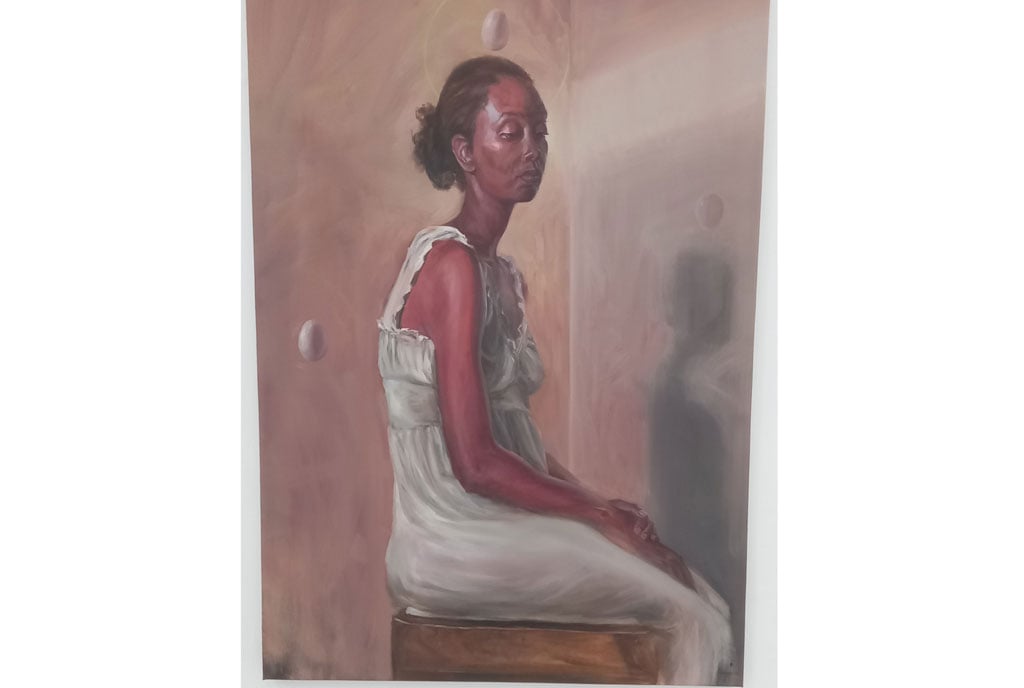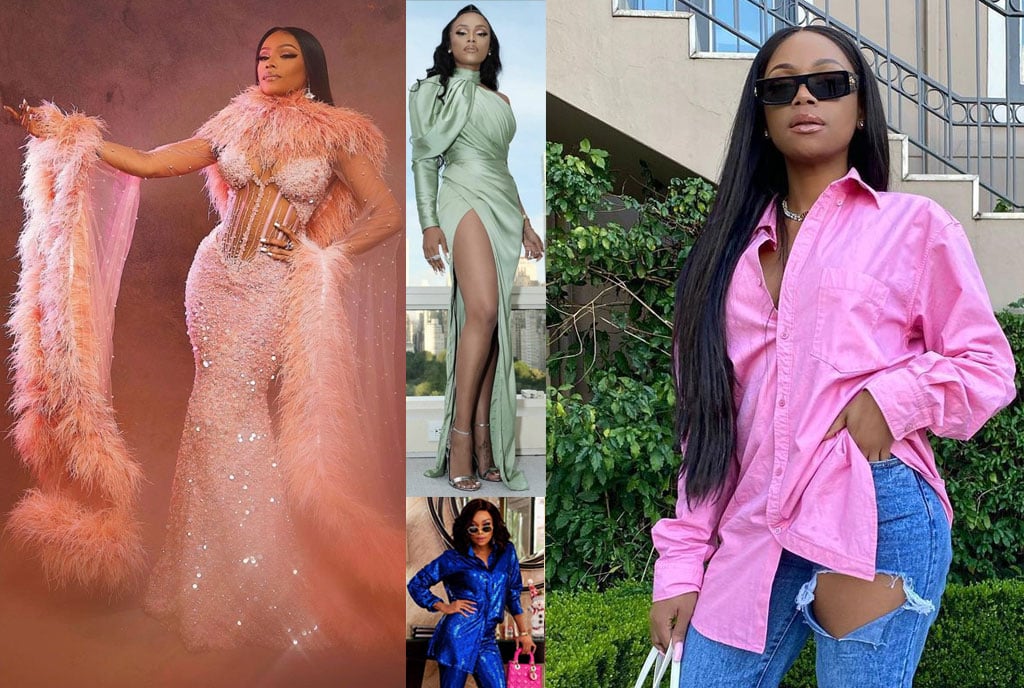Prime
Eight Kenyan artists exhibiting in Kampala

Florence Wangui’s Sitting Transition II painting. PHOTO/BAMUTURAKI MUSINGUZI
What you need to know:
- As diverse as the artists’ works are, they are united by their extraordinary ways to explore their subject matter intellectually and poetically, pushing to boundaries familiar to them and their audiences.
Eight Kenyan artists are featuring in a group exhibition titled Walking the Edge at the Afriart Gallery on 7th Street, Industrial Area in Kampala.
The exhibition that opened on November 26, 2022 will close on January 28 and it features April Kamunde, Boniface Maina, Elias Mung’ora, Florence Wangui, Lemek Sompoika, Onyis Martin, Paul Onditi and Peterson Kamwathi.
As diverse as their artistic practice is, they are, however, united by their extraordinary ways to explore their subject matter intellectually and poetically, and courageously pushing boundaries of the known and familiar to them and their audiences.
Maina’s intricate works on paper are surreal, at times cryptic, yet figurative. He has three artworks; An Encounter, The Circus 1, and The Circus 2.
An Encounter by Maina talks about self-interrogation, especially after making decisions in our daily life whereby one has to face themselves according to the outcome of the decisions. “It is therefore akin to looking in the mirror and becoming your own judge of what reflects. It is an encounter with one self,” he says.
Maina’s The Circus 1 highlights the narrative of how ideologies are sold to the masses (politics, religion, classism, voodoo, beggar market, among others) and the similarities in how lies become the pivotal means of persuasion. Here the individuals are compiled in one picture plane, all playing the role of “the saviour” to the poor and bed-ridden.
Kamwathi’s prolific practice, materialised mostly in thematic series, has four pieces titled Community under the Noble Savage series of artworks which began in 2019 and is ongoing.
“The series looks at the place of the individual within a collective and the likely perceptions generated as a result of that positioning. In the works preceding this series, I explored the structure of the group by multiplying a singular individual in order to create the impression/optics of a grouping,” Kamwathi said.
According to Kamwathi, in the Community etchings, the individual or group occupies a scene that includes elements that can emerge as a result of collective enterprise. For example, groupings and intrigue “(Community VI),” collective identities based on colonial classification and territorial conquest “(Community III),” collective borders and personal boundaries “(Community II),” and communal rites of passage “(Community I).”
Wangui’s paintings ooze a melancholic, fragile yet powerful, and graceful aura. Her astonishing portraits show predominantly women in deep introspection, seemingly nearly turning the figures’ internal psychic realities and their physical bodies inside out.
Wangui’s Sitting Transition II shows a woman sitting on a stool in deep introspection with an egg on top of her head and back.
Kamunde’s recent body of work explores meanings of rest and the pursuit of it. The work is driven by personal reflection and response to feelings of weariness triggered by a rapidly changing world and the endeavor to live a successful and fulfilling life in fast-paced Nairobi. Here, rest becomes a space of liminal experiences requiring courage and acceptance of chance.
Kamunde has two works; Sometimes The Sun Makes It Easier To Detangle Your Thoughts showing a woman seated on a blue plastic chair under a shade of a tree, and All the Women in Me are Tired shows a woman looking down at her feet while seated on a blue plastic chair.
Mung’ora works along inquiries of personal and national archives and memory. It becomes a space to interrogate the non-static nature of memory, its inseparable relationship with the present and future, and how it is, in fact, a liminal space of indefinite meaning and knowledge production.
Mung’ora’s works are A Countries Sacrificial Lamb and Wanji. A Countries Sacrificial Lamb captures several scenes, including a flock of sheep drinking water from a trough; a group of men slaughtering a lamb and a lamb dressed in cloth with the abbreviation UDA on its side.
Mung’ora says A Countries Sacrificial Lamb was inspired by the appearance of goats on campaign trails during the recent political rallies held across Kenya. Different groups would offer these animals to aspirants as gifts and in a show of support they would even have the candidates’ colours and slogans painted directly onto the goats’ fur.
On other occasions the goat played a different role in this political process. In an effort to build political support some aspirants went to the tribal elders for blessings. In the case of the Kikuyu, the elders sacrificed goats at ceremonies to crown these leaders. In cases of disputes, goats were sacrificed during ceremonies to curse political opponents, Mung’ora adds.
“It intrigued me as to how this animal, an “innocent bystander” was dragged into this process and most often sacrificed at the altar of this political theater,” Mung’ora says. “It serves as a useful symbol to think about the way the political class relates to the electorate and how this shapes the politics and governance of the today.”
Mung’ora says Wanji is a portrait painting of his sister relaxing in the house. “This is part of an ongoing body of paintings of my family and close friends. It is a space where I get to express and sometimes interrogate these relationships, their importance in my life and in shaping who I am today.”
Mung’ora is hoping that Wanji provides space for audiences to reflect on these settings in their own lives.
Sompoika is a Nairobi-based artist who grew up in a rural Massai community. This contrast in his biography drives his work, which perhaps guides us to the ambiguity of identity and the fact that it does not merely exist, but is often continuously and painfully disputed within liminal spaces. He has three “Untitled” pieces on pastel, charcoal and graphite on paper.
Onyis tackles shared global experiences such as migration, human trafficking, and consumerism, yet also leans towards an introspective departure point in his work. Using his personal life experience and connectedness to urban contemporary culture, both physical and identity-related mental displacement are dominant features. He has three works; Huu Ndio Mwili Wangu I, Huu Ndio Mwili Wangu 2, and Huu Ndio Mwili Wangu 3.
Onditi’s richly-layered paintings may invoke a sense of uneasiness in the viewers’ eyes. He is a master of visually creating imaginary worlds, placing figures into a meticulously fragmented space, in which there seems to be no beginning and no end. He has three works; Sporadic, Situation, and Balcony Series.





